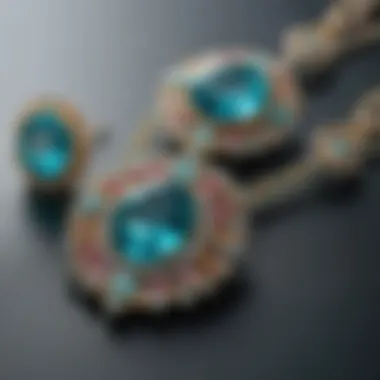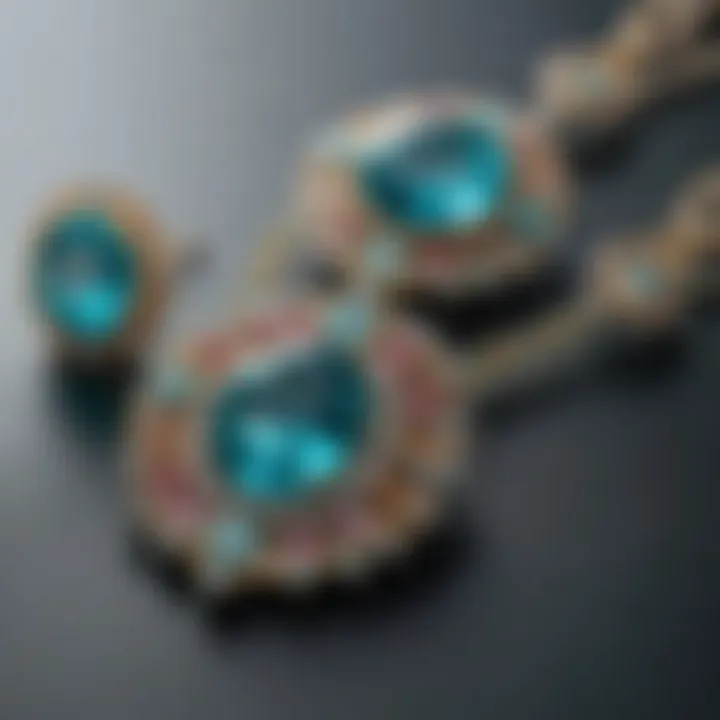Exploring the Allure of Paraiba Jewellery and Its Significance


Intro
Paraiba jewellery has carved a distinguished niche for itself in the world of gemstones, with its captivating hues and irreplaceable charm. But what exactly makes this jewellery so special? Well, it's more than just an eye-catching accessory; it's a fascinating blend of nature's artistry and the human touch.
This article embarks on a journey through the realms of Paraiba jewellery, highlighting its unique characteristics and historical roots while examining its contemporary significance in today’s market. From the moment this gem twinkled under the Brazilian sun to the luxurious jewelry pieces it adorns today, we will explore the tales and science behind Paraiba tourmaline.
Gemstone Overview
Definition and Origins
Paraiba tourmaline is a rare variety of tourmaline known for its vibrant colors, especially those reminiscent of the hues of a tropical sea. Discovered in Brazil's Paraíba state in the late 1980s, the gemstone quickly gained recognition among gem enthusiasts and collectors for its distinctive electric blue and green shades, attributed to the presence of copper within its structure. Its allure is not just in its beauty, but in its geological story—a narrative of volcanic activity and mineral formation that unfolded eons ago.
Paraiba’s distinctiveness lies not only in its color but also in the geological environments from which it originates. While Brazil remains the most well-known source, deposits have also been found in Nigeria and Mozambique, adding to the gemstone's mystique and desirability.
Historical Significance
Since its discovery, Paraiba tourmaline has seen a meteoric rise in popularity. Initially, it was relatively unknown and considered among lesser gemstones until the unique colors came to light. In the blink of an eye, this previously obscure mineral became a hot commodity, coveted by jewelers and collectors worldwide. Its introduction in the late 80s catapulted it into the luminary world of high-end jewelry.
The relatively short history of Paraiba tourmaline is fascinating. As it gained traction, it not only sparked interest in gem collectors but also appeared in the collections of celebrities and royalty alike. The likes of red carpet events witnessed stars draped in the brilliant gleam of Paraiba jewellery, thus solidifying its status as a symbol of luxury. This gemstone, now synonymous with exclusivity, has played a part in the evolution of gemstone valuation itself, impacting how we view both beauty and investment potential.
Gemstone Properties
Hardness and Durability
Paraiba tourmaline is no slouch when it comes to hardness. With a rating of 7 to 7.5 on the Mohs scale, it exhibits commendable durability, making it suitable for everyday wear, assuming care is taken. However, being mindful of its setting and the physical activities one engages in is wise. The jewellery pieces adorning this gem deserve gentle handling to maintain their brilliance.
Color and Clarity
The color spectrum of Paraiba jewellery can be a feast for the eyes, ranging from vibrant turquoise to deep blue and green tones, with some displaying reddish purple shades. Its clarity can vary, and while some pieces may possess inclusions, a well-crafted Paraiba gem often blows viewers away with its transparency and luminosity. Authentic Paraiba tourmaline jewelry is typically faceted to enhance these colors, playing with light to create a dazzling spectacle that is hard to replicate.
"Paraiba tourmaline’s array of colors is a vibrant testament to nature’s grandeur, blending science and art in a way that few other gemstones can."
Prelims to Paraiba Jewellery
Understanding Paraiba jewellery opens up a world where rarity meets beauty, each piece glimmering with tales of its geological origins and cultural implications. This introduction serves to establish why Paraiba jewellery has become a beacon for collectors, designers, and enthusiasts alike.
The primary allure lies in Paraiba tourmaline, known for its extraordinary color spectrum, ranging from vibrant turquoise to deep blues and greens. This isn’t just a rock; it's a phenomenon, making every piece not only elegant but also a conversation starter.
Engaging with Paraiba jewellery isn’t just about aesthetics; it encompasses a deeper appreciation for its unique qualities and the impacts of its surroundings. The jewellery often signifies individuality and prestige, setting apart those who wear it from mainstream trends.
The benefits of understanding Paraiba jewellery stretch from gaining knowledge about its qualities to dipping into its rich history. Potential buyers and connoisseurs can greatly enhance their experience, ensuring that each piece they own is not merely an accessory but a cherished testament to craftsmanship and nature's artistry.
"Paraiba jewellery isn't just an adornment; it's a tangible link to the earth’s history and a reflection of personal identity."
In this article, we will explore Paraiba in detail, beginning with its definition, then progressing through its historical context, leading to the geological origins that define it.
The relevance of delving into these facets cannot be overstated. For gemstone enthusiasts, collectors, and jewellery designers, having a comprehensive grasp of why Paraiba jewellery holds its value elevates the overall appreciation, ensuring decisions are informed by knowledge rather than impulse.
The Exceptional Qualities of Paraiba Tourmaline
When it comes to gemstones, Paraiba tourmaline stands out in the crowd, boasting qualities that genuinely set it apart. This section will delve into its most exceptional traits, emphasizing why it's not just another pretty face in the world of jewels. The distinctive qualities of Paraiba tourmaline are paramount, playing a significant role in its allure and desirability among collectors and enthusiasts alike. Understanding these characteristics offers insights not just into the gem’s physical beauty but also into its cultural and economic significance.
Color Range and Significance
Paraiba tourmaline is renowned for its vibrant color, which ranges from neon blue to vibrant green, often with striking electric hues that seem to glow from within. This extensive range is not merely eye-catching; it evokes emotional connections and symbolizes vitality and creativity in various cultures. In fact, many gem aficionados consider the color of Paraiba tourmaline to be its most defining feature.
- The Hue Spectrum: A warm glow of purples adds depth, while electric blues can appear almost luminescent, drawing the gaze and triggering curiosity. These colors are due to the presence of copper and manganese during the stone's formation, contributing to their unique visual characteristics.
- Cultural Significance: Different cultures interpret these colors variably, often as guardians of luck or symbols of prosperity. The blue hues, reminiscent of tropical waters, evoke a sense of calm and tranquility, while the vibrant greens represent growth and renewal.
The significance of color in Paraiba tourmaline can't be overstated. Each shade tells a story – not just of its geological formation but also of the values and beliefs it represents in global societies.


Clarity and Transparency
Clarity and transparency are crucial characteristics that can sway a buyer’s interest. In the case of Paraiba tourmaline, the clarity generally ranges from eye-clean to those with visible inclusions. However, this does not diminish its appeal; rather, it adds a layer of authenticity.
"A high-quality Paraiba, with clear transparency, can fetch prices that make even seasoned collectors swoon."
- Indicators of Quality: Clear stones display vibrant color with a depth that can enthrall. On the other hand, slight inclusions provide a fingerprint of nature, reflecting the gem’s unique journey.
- Enhanced Values: Transparent Paraibas are generally in higher demand, leading to increased market values. Collectors often seek clarity in gemstones, equating it with prestige and desirability.
In essence, while clarity might seem like a straightforward metric, in Paraiba tourmaline, it's wrapped up in layers of meaning, history, and investment potential. Assessing these qualities lays the groundwork for understanding the significance and allure of this remarkable gemstone.
Geological Origins of Paraiba Tourmaline
Understanding the geological origins of Paraiba tourmaline is crucial in unraveling the gemstone's mystique and allure. The source locations not only determine its unique characteristics but also influence its value in the market. As this gem emerges from the depths of the Earth, its formation and journey tell a story of thousands of years, rich with mineral details and geological events. Thus, geology serves as the backbone of any discussion surrounding Paraiba jewellery, laying the foundation for appreciation and investment.
Source Locations
Paraiba tourmaline boasts an almost mythical status, particularly due to its exclusive origins. The most renowned deposit is located in the Paraíba state of Brazil. Here, in the 1980s, miners stumbled upon an extraordinary find that would change the gemstone industry forever. The vibrant hues of blue and green were unlike any other tourmalines on the market. The rarity and beauty of these stones stemmed not just from their color, but from their unique geological environment.
In addition to Brazil, there are notable occurrences of Paraiba tourmaline mined from Nigeria and Mozambique. These regions have unearthed stones of striking quality, often showcasing the same stunning color palette as their Brazilian counterparts. Collectors have taken a keen interest in these stones, although the Brazilian finds remain the most coveted due to their historical significance. Here's a closer look at the source countries:
- **Brazil:
- **Nigeria:
- **Mozambique:
- Paraíba State: The birthplace of Paraiba tourmaline, characterized by its unique electrifying shades that mesmerize all who gaze upon them.**
- Oyo and Kaduna states are known for producing tourmalines with a similar chromatic quality. Local miners have brought forth some beauties that are increasingly appreciated by the global market.**
- This African region has recently entered the spotlight as it yields vibrant tourmalines, often mirroring the enchanting hues typical of Brazilian stones.**
Paraiba tourmaline's origins in these regions confer a distinct value based upon geological scarcity, reinforcing its status as a sought-after gem.
Mining Techniques
The mining techniques used to extract Paraiba tourmaline play a vital role in both the quality of the gems and the environmental implications of their extraction. Traditional mining methods can range from artisanal to small-scale workings, often in difficult terrain and challenging conditions. Miners utilize hand tools, such as picks and shovels, to extract the minerals from the earth, made all the more intricate by the need for careful navigation of local geology.
In more recent years, some operations have begun to adopt mechanized techniques that allow for more efficient mining. These modern methods come with their own set of considerations, including the potential environmental impact of larger-scale operations. The delicate balance between successful mineral extraction and environmental preservation remains a topic of ongoing discussion in the gemstone community.
Challenges in mining:
- **Environmental Impact:
- **Labor Conditions:
- Considerations include the potential disruption to local ecosystems, land degradation, and water pollution.**
- Often faced with difficult working conditions, miners may lack safety equipment and reasonable wages.**
By understanding the mining techniques employed in the extraction of Paraiba tourmaline, one can appreciate not just the gem itself but also the stories and struggles imbued within its journey from the earth to craftsmanship.
Craftsmanship in Paraiba Jewellery
When browsing the realm of fine jewellery, craftsmanship stands as the backbone supporting the allure of any piece, and Paraiba jewellery is no exception. It's not merely about selecting an exquisite stone; it’s the artistry involved in breathign life into that stone that sets Paraiba apart. Encapsulated within every piece is a confluence of skill, tradition, and innovative techniques that reflect the unique characteristics of Paraiba tourmaline.
The craftsmanship involved in Paraiba jewellery highlights several crucial elements. First, it allows for the true aesthetic potential of the tourmaline to shine. Each stone's vibrant blue to green hues require careful consideration in design choices, ensuring that the final piece resonates with the inherent beauty of the gem it showcases. The meticulous attention to detail in crafting the jewellery can significantly influence how light interacts with each stone, enhancing its natural brilliance.
Secondly, good craftsmanship emphasizes the durability and wearability of the final product. Paraiba tourmaline is valued not just for its remarkable colour but also for its relatively high ranking in hardness compared to other gemstones. Skilled artisans choose metal alloys and settings thoughtfully, which ensures that the jewellery can withstand daily wear while maintaining its luster and charm over time.
A further consideration is the emotional connection that craftsmanship fosters between the wearer and the piece. People often treasure jewellery for its personal significance or its historical background. Artisans often weave stories and cultural elements into their designs which add layers of meaning to the jewellery. This blend of craftsmanship and symbolism can elevate a simple piece into something truly extraordinary.
Design Techniques
Limited only by imagination, the design techniques used in crafting Paraiba jewellery can vary widely, reflecting personal styles and preferences. Artisans employ a blend of traditional and modern methods to create pieces that are as unique as the stones themselves.


- Custom Cuts: The cutting of Paraiba tourmaline can significantly affect its appearance. Skilled jewellers use techniques like faceting or cabochon cutting to capitalize on the stone's colour and clarity. Faceted stones can reflect light brilliantly, while cabochon cuts exhibit smoothness.
- Mixed Media: Many designers often incorporate other materials, such as gold, platinum, or even unconventional materials like wood or resin, to create a dialogue between the Paraiba tourmaline and its surrounding elements. This exploration of mixed media establishes a visual harmony that enhances the overall design.
- Artisan Techniques: Techniques such as hand engraving or filigree work can add texture and complexity to designs, making the jewellery more captivating. These specialized skills are often passed down through generations and reflect the jeweller's craftsmanship.
Setting Styles
The setting styles employed in Paraiba jewellery play a vital role in demonstrating the gem's characteristics while providing security and beauty to each piece.
- Prong Settings: Often used for their minimalistic approach, prong settings allow the stone to breathe and maximize light exposure, which accentuates the colour and brilliance of the Paraiba.
- Bezel Settings: By encasing the gemstone in metal, bezel settings provide optimal safety for the fragile tourmaline while offering a sleek and modern appearance. This style is excellent for more active wearers.
- Halo Settings: A halo design incorporates smaller stones surrounding the Paraiba, emphasizing its brilliance. This technique adds glamour and draws the eye towards the centerpiece.
"Great craftsmanship is not just seen; it is felt in the experience of wearing a piece of jewellery. It connects the wearer to a legacy of artistry and tradition."
Each choice in design and setting not only optimizes the visibility and security of the Paraiba tourmaline but also resonates with the collector's or wearer's sense of identity.
In summation, the artistry that goes into crafting Paraiba jewellery cannot be overstated. The elegant results of these techniques highlight the natural beauty of Paraiba tourmaline while providing a personal touch that elevates the item from mere decoration to something of profound value.
Cultural Impact of Paraiba Tourmaline
The allure of Paraiba tourmaline stretches beyond its breathtaking colors and rarity. Its cultural impact weaves a rich tapestry that highlights the gemstone’s significance in various societies. From ancient beliefs to its contemporary uses in art and fashion, Paraiba some how reflects the desires, values, and stories of the people who cherish it. Understanding this cultural context offers a holistic view into whyParaiba tourmaline is not merely a pretty stone, but a symbol enmeshed with deep meanings.
Symbolism in Different Cultures
Throughout history, gemstones have often been assigned meanings that resonate with human experiences. Paraiba tourmaline is no exception. In many cultures, the vibrant hues of this gemstone are linked to varied interpretations:
- Healing Properties: Some believe that Paraiba tourmaline holds the power to heal emotional scars, providing comfort and peace. In particular, it is often seen as a source of inspiration and personal empowerment.
- Connection to the Divine: Ancient civilizations often viewed gemstones as earthy representations of divine attributes. The stunning blue and green flecks of Paraiba have led some to associate it with water — symbolizing life, refreshment, and renewal.
- Status and Wealth: In more contemporary contexts, owning Paraiba jewellery has come to signify prestige and luxurious taste. Its rarity commands respect and admiration among collectors and enthusiasts, making it a status symbol in various social circles.
"Paraiba tourmaline is more than just a gemstone; it carries whispers of meaning that shape identities across cultures."
This wide range of symbolic meanings reflects the multifaceted nature of Paraiba tourmaline, resonating with different values, beliefs, and aspirations across the globe.
Paraiba in Art and Fashion
The impact of Paraiba tourmaline extends far into the realms of art and fashion. Designers have harnessed its unique beauty to create iconic pieces that turn heads and capture hearts. In recent years, its integration into fashion showcases how gemstones can serve not just as accessories but as central elements of artistic expression.
- Fashion Runways: Top designers have often showcased Paraiba in luxury collections, using its vibrant colors to create statement pieces that blend traditional elegance with modern flair. A striking piece featuring Paraiba can elevate any ensemble, drawing attention and admiration.
- Art Installations: Artists have also taken note of the visual allure of Paraiba. From sculptures to contemporary jewelry pieces, its striking colors are utilized to evoke emotions, spark conversations, and even challenge societal norms.
- Celebrities and Influence: Many high-profile personalities advocate for Paraiba, often spotted in red-carpet events wearing stunning jewelry pieces that feature this exquisite gemstone. Their choices influence public perception, driving interest and admiration for the stone among fashion-savvy individuals.
In addition, the interplay between culture and gemstone usage illustrates how Paraiba tourmaline has evolved from a rare find in the earth to a darling of the art world, revealing its endless potential to captivate hearts and minds.
The cultural significance of Paraiba tourmaline is profound. From ancient beliefs about healing and status to its prominent role in modern fashion and art, this extraordinary gemstone embodies a rich legacy that continues to inspire and resonate with enthusiasts and collectors alike.
Investment Potential of Paraiba Jewellery
The realm of Paraiba jewellery is not just about aesthetic appeal; it intertwines with the financial landscape of gemstones. Paraiba tourmaline, with its vivid colors and rarity, stands as an investment that continues to attract both jewel enthusiasts and astute investors. As a purchaser, grasping the nuances behind the investment potential of Paraiba jewellery can yield substantial benefits, fundamentally altering one's portfolio.
The market for Paraiba tourmaline has witnessed a remarkable evolution. Investors and collectors alike recognize its worth, making it a flourishing segment in the overall gemstone market. The unique characteristics of this particular stone — its striking hues ranging from turquoise to electric blue — set it apart decisively. Such distinct features contribute to a growing desirability, leading to increased market value.
Market Trends and Value Appreciation
The investment potential of Paraiba jewellery cannot be discussed without acknowledging its rising market trends. Over recent years, the demand for this gemstone has surged, largely fueled by its scarcity. Mining efforts have dwindled since significant discoveries in the 1980s, concentrating supplies in the hands of a few. Consequently, the laws of supply and demand dictate that as fewer stones become available, their value increases.
This upward trend is evident when you examine auction results. For instance, pieces featuring high-quality Paraiba tourmaline often fetch astronomical prices, citing increased interest from high-net-worth individuals eager to invest in tangible assets.
"The rarity of Paraiba tourmaline – coupled with its spellbinding color – makes it a sought-after choice for those looking to combine beauty with investment."
Furthermore, tracking auction houses like Sotheby’s and Christie’s can provide insights into how prices for Paraiba gemstones appreciate over time. Investors are recognizing that these gemstones are not merely ornamental; they are becoming a form of wealth preservation, particularly in times of economic uncertainty.
Purchasing Strategies for Collectors
For collectors eyeing Paraiba jewellery, it’s crucial to employ savvy purchasing strategies. Firstly, understanding the differences in quality is vital. Various factors play a role in determining the value of a particular piece, such as:
- Color Intensity: The more vibrant and vivid the color, the higher the value.
- Clarity: Pieces with fewer inclusions or flaws command more attention.
- Origin: Stones sourced from the original Brazilian mines are often considered more prestigious than others.


It’s also advisable to establish a relationship with reputable dealers. These professionals can provide insights into upcoming collections and market trends. Starting with a small, high-quality piece can be an astute move for beginners, allowing them to familiarize themselves with the nuances without making a significant investment upfront.
Joining gem fairs and trade shows can also be instrumental. These gatherings not only provide exposure to a broader range of pieces but also foster connections with other collectors and dealers. Networking is invaluable in this scene, as knowledge shared among enthusiasts can often lead to discovering hidden gems worth pursuing.
By creatively navigating the market, considering quality over quantity, and making informed connections, collectors can position themselves wisely in this flourishing niche of investment jewellery.
Care and Maintenance of Paraiba Jewellery
Paraiba jewellery, renowned for its stunning colors and rarity, demands special attention in terms of care and maintenance. As an exquisite gem, Paraiba tourmaline has features that make it both a visual delight and a delicate investment. Proper care not only preserves the beauty of these pieces but also ensures their longevity, allowing collectors and enthusiasts to fully appreciate their value over time.
When owning Paraiba jewellery, it’s essential to recognize that these gems are relatively soft compared to other stones like diamonds. Thus, mishandling could lead to scratches or even more serious damage. Keeping your jewellery in prime condition requires a few thoughtful practices.
Cleaning Guidelines
Cleaning Paraiba jewellery is not a one-size-fits-all approach. It’s important to understand the specific methods that will keep the gemstone sparkling while avoiding degradation. Generally, you should follow these simple yet effective steps:
- Use Mild Soap: A gentle dish soap with warm water is the best start. Avoid harsh chemicals that could cloud the surface or dull its brilliance.
- Microfiber Cloth: Employ a soft microfiber cloth to gently wipe the stone after wearing it. This can help remove oils and dirt build-up while reducing potential scratches.
- Soft Brush: If deeper cleaning is necessary, use a soft-bristled toothbrush to access hard-to-reach areas. Be gentle to avoid marring the stone’s surface.
A little care goes a long way; remember to clean your Paraiba jewellery regularly to maintain its vibrant appearance.
Storage Recommendations
Storing Paraiba jewellery correctly is just as crucial as cleaning it. Proper storage helps prevent physical damage and keeps the pieces untarnished. Here are some insightful storage tips:
- Separate Compartments: When placing your jewellery in a jewelry box, ensure that each piece is kept in its own compartment. This prevents them from scratching against each other.
- Padded Lining: Opt for a jewelry box with soft, padded linings—this offers a gentle resting place for your cherished gems.
- Avoid Humidity: Since moisture can adversely affect the tourmaline, it's best to store your pieces in a dry area. A silica gel packet placed in the storage can help absorb excess moisture.
Taking these care and maintenance steps seriously ensures that your Paraiba jewellery retains its charm and enhances your overall collection. By following these guidelines, you protect your investment while allowing the beauty of the Paraiba tourmaline to shine through for many more years to come.
The Future of Paraiba Jewellery
As we look ahead, the journey of Paraiba jewellery is poised to take on new dimensions, merging tradition with modern values. The landscape of the jewelry market is ever-evolving, and Paraiba pieces are no exception to the currents shaping consumer preferences. This portion of the article sheds light on two crucial aspects that are likely to impact the future of Paraiba jewellery: sustainability and innovations in gemstone use.
Sustainability and Ethical Concerns
The rising global consciousness around sustainability has cast a bright spotlight on the jewellery industry, which has not always had the best track record regarding ethical sourcing and environmental impact. Consumers, especially younger buyers, are increasingly asking questions about where their gemstones come from and under what conditions they were mined. As it stands, the story behind Paraiba tourmaline is not just about its stunning color; it also encompasses the processes involved in its extraction and distribution.
Sustainability in Paraiba jewellery can evolve through several methods:
- Responsible Mining Practices: Mining must adopt techniques that minimize environmental damage and promote ecological restoration. Using methods that reduce water usage, fine-tuning how ore is extracted, and even restoring the mined areas are steps in the right direction.
- Supply Chain Transparency: Consumers crave assurance that their jewelry is sourced ethically. Paraiba jewellers could increasingly provide clear information about their supply chains, confirming that stones are mined responsibly and laborers are treated fairly.
- Recycling and Upcycling: No longer will the notion of ‘new’ be the only goal; rather, there’s room for old pieces to be reimagined. This presents an exciting opportunity for designers to create unique jewellery pieces from old Paraiba stones, adding a new chapter to their life.
Thus, by embracing sustainability, the market for Paraiba jewellery not only meets buyer demands but also elevates the entire industry's standards, fostering a more conscientious approach.
Innovations in Gemstone Use
The world of gemstones is poised for transformation as innovation takes the front seat. Traditional uses of Paraiba tourmaline in jewellery are likely to expand as technology and design converge, leading to the creation of distinctive pieces that cater to modern tastes. The stunning vibrancy of this unique gemstone opens doors that designers of past generations could only dream of. Here are a few ways innovation might flourish:
- Lab-Created Paraiba Gemstones: While real Paraiba tourmaline is coveted, advances in technology can produce lab-created versions that closely mimic the properties and beauty of the natural stones. These alternatives can offer a more accessible price point and allow for wider distribution.
- 3D Printing in Jewellery Design: As designers harness the capabilities of 3D printing, new forms of Paraiba jewellery could merge bold artistic visions with state-of-the-art technology, resulting in avant-garde pieces that push boundaries.
- Smart Jewelry Integration: Wearable technology is on the rise, and integrating Paraiba gemstones into smart jewelry could forge a connection between style and function. Imagine rings or bracelets that still boast the allure of these gorgeous stones while offering digital features.
These innovations will likely play an essential role in keeping the allure of Paraiba jewellery alive, appealing to both collectors and new generations.
"In the future, Paraiba jewellery may not only be a symbol of beauty but also a testament to ethical evolution."
The future of Paraiba jewellery is rich with possibilities, nurturing a balance between craftsmanship, ethics, and innovation. By addressing these emerging trends, the industry not only ensures its survival but also thrives in a landscape where conscious consumerism is crucial.
Epilogue
The conclusion serves as a pivotal component in solidifying the arguments and insights presented about Paraiba jewellery throughout the article. It is at this juncture that all the vibrant threads of history, craftsmanship, and investment potential weave together to form a coherent understanding of why this gemstone captivates so many.
Summarizing the Allure of Paraiba
Paraiba jewellery is more than just a collection of pieces. It embodies a rich narrative steeped in geological wonders and cultural significance. The vivid colors that dance within the Paraiba tourmaline, from electric blues to verdant greens, are a feast for the eyes. Each piece tells a story of its origins from the heart of Brazil and how it traveled through time to adorn the fingers and ears of jewel lovers around the globe.
The exceptional qualities of Paraiba make it a desirable gemstone not just for wear but as an investment. Buyers often find it a thrilling experience to own a piece so unique, one that holds both beauty and value. The market trends discussed show that this interest is likely to grow, encouraging both collectors and new enthusiasts to dive deeper into this world.
Moreover, the cultural symbolism associated with Paraiba provides an additional layer of intrigue. It resonates with various traditions and arts, enriching the gemstone's significance beyond mere aesthetics.
In summary, the allure of Paraiba jewellery lies not only in its stunning appearance but also in its compelling history, craftsmanship, and status in the modern market. For gemstone enthusiasts, collectors, and jewellery designers, it is a treasure trove of inspiration and knowledge, promising continued fascination in times to come.



